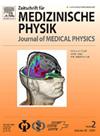乳房切除术后放疗:栓剂厚度和照射技术对皮肤剂量的影响。
IF 4.2
4区 医学
Q2 RADIOLOGY, NUCLEAR MEDICINE & MEDICAL IMAGING
引用次数: 0
摘要
目的:确定以 10 MV IMRT 和 VMAT 为基础的方案,每天注射以 45 Gy 皮肤剂量为目标的栓剂,以便在乳房切除术后的放射治疗中用隔天注射 5 mm 厚栓剂的方法取代 6 MV 切向场:我们测量了滑动窗口 IMRT 和 VMAT 计划中不同栓剂厚度对胸壁 PTV 平均表面剂量的影响。我们分析了表面剂量曲线和剂量均匀性,并与我们的标准 6 MV 策略进行了比较。所有测量都是在带有 Gafchromic 胶片的胸腔模型上进行的,而剂量测定计划则是使用 Acuros XB 算法(瓦里安)计算的:我们利用每天 3 毫米厚的栓剂,在测得的表面剂量(平均剂量和均匀性)与文献中获得的皮肤毒性阈值之间取得了最佳折衷。IMRT 和 VMAT 技术的平均表面剂量分别为规定剂量的 91.4 ± 2.8% [85.7% - 95.4%] 和 92.2 ± 2.3% [85.6% - 95.2%]。我们的标准 6 MV 隔天 5 mm 厚的栓剂可达到 89.0 ± 3.7% [83.6% - 95.5%]。结论:基于 10 MV IMRT 的方案,每天使用 3 毫米厚的栓剂,产生的表面剂量与隔天使用标准 6 MV 5 毫米厚栓剂的方法相当,但表面剂量均匀性有所提高。这可以更好地控制皮肤毒性和靶体积覆盖。本文章由计算机程序翻译,如有差异,请以英文原文为准。
Post-mastectomy radiotherapy: Impact of bolus thickness and irradiation technique on skin dose
Purpose
To determine 10 MV IMRT and VMAT based protocols with a daily bolus targeting a skin dose of 45 Gy in order to replace the 6 MV tangential fields with a 5 mm thick bolus on alternate days method for post-mastectomy radiotherapy.
Method
We measured the mean surface dose along the chest wall PTV as a function of different bolus thicknesses for sliding window IMRT and VMAT plans. We analyzed surface dose profiles and dose homogeneities and compared them to our standard 6 MV strategy. All measurements were performed on a thorax phantom with Gafchromic films while dosimetric plans were computed using the Acuros XB algorithm (Varian).
Results
We obtained the best compromise between measured surface dose (mean dose and homogeneity) and skin toxicity threshold obtained from the literature using a daily 3 mm thick bolus. Mean surface doses were 91.4 ± 2.8% [85.7% – 95.4%] and 92.2 ± 2.3% [85.6% – 95.2%] of the prescribed dose with IMRT and VMAT techniques, respectively. Our standard 6 MV alternate days 5 mm thick bolus leads to 89.0 ± 3.7% [83.6% – 95.5%]. Mean dose differences between measured and TPS results were < 3.2% for depths as low as 2 mm depth.
Conclusion
10 MV IMRT-based protocols with a daily 3 mm thick bolus produce a surface dose comparable to the standard 6 MV 5 mm thick bolus on alternate days method but with an improved surface dose homogeneity. This allows for a better control of skin toxicity and target volume coverage.
求助全文
通过发布文献求助,成功后即可免费获取论文全文。
去求助
来源期刊
CiteScore
3.70
自引率
10.00%
发文量
69
审稿时长
65 days
期刊介绍:
Zeitschrift fur Medizinische Physik (Journal of Medical Physics) is an official organ of the German and Austrian Society of Medical Physic and the Swiss Society of Radiobiology and Medical Physics.The Journal is a platform for basic research and practical applications of physical procedures in medical diagnostics and therapy. The articles are reviewed following international standards of peer reviewing.
Focuses of the articles are:
-Biophysical methods in radiation therapy and nuclear medicine
-Dosimetry and radiation protection
-Radiological diagnostics and quality assurance
-Modern imaging techniques, such as computed tomography, magnetic resonance imaging, positron emission tomography
-Ultrasonography diagnostics, application of laser and UV rays
-Electronic processing of biosignals
-Artificial intelligence and machine learning in medical physics
In the Journal, the latest scientific insights find their expression in the form of original articles, reviews, technical communications, and information for the clinical practice.

 求助内容:
求助内容: 应助结果提醒方式:
应助结果提醒方式:


